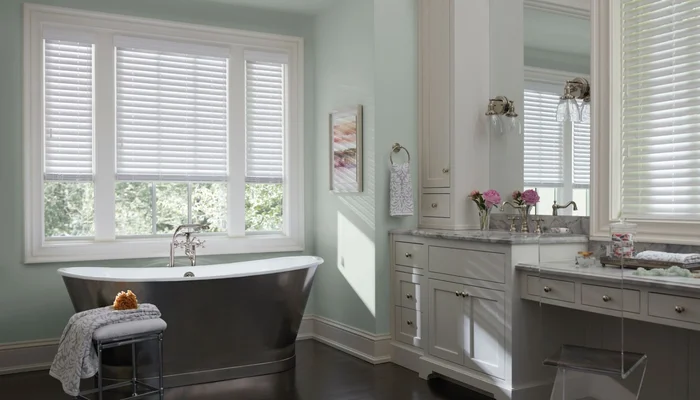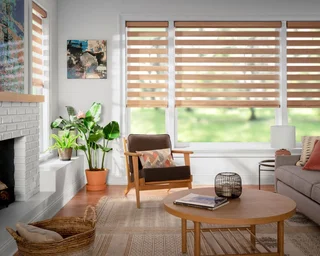
Window treatments are a pivotal aspect of home décor, setting the tone of a room’s aesthetic while fulfilling practical functions like privacy and light control. Among the myriad options available to homeowners, faux wood blinds stand out as a versatile and sophisticated choice.
These blinds offer the classic elegance of wood with the added resilience of synthetic materials, making them a smart option for those looking to enhance their living spaces.
The introduction of faux wood blinds into the market has revolutionized window treatments by providing an accessible alternative to traditional wood blinds, which marries functionality with style.
This article serves as an ultimate guide to navigate the selection of faux wood blinds, ensuring that your home radiates timeless elegance and style. Faux wood blinds have been gaining popularity in modern interior design, not just for their affordability but also for their aesthetic flexibility.
They are designed to resist moisture and heat, making them suitable for a variety of environments where real wood could warp or fade. This guide will delve into what faux wood blinds are, how they compare to their real wood counterparts, and why they might be the best choice for your home.
From understanding the basic composition to exploring the range of finishes and styles available, this article will equip you with the knowledge to make an informed decision on choosing faux wood blinds that will stand the test of time and fashion.
What are Faux Wood Blinds?
Faux wood blinds are a contemporary marvel in the world of window furnishings, crafted to emulate the rich texture and warmth of real wood blinds while being constructed from synthetic materials.
Typically made from vinyl or a blend of composite wood materials, these blinds offer homeowners the look and feel of wood without the inherent drawbacks. Real wood blinds, while luxurious, can be susceptible to damage from the sun’s rays and humidity, leading to warping or cracking over time.
In contrast, faux wood is engineered for durability, retaining its shape and color even in high-moisture areas like bathrooms and kitchens or in regions with extreme temperature variations.
The manufacturing process of faux wood blinds involves high-quality PVC, vinyl, or a composite of wood and plastic materials that are designed to withstand UV radiation and moisture without fading, peeling, or deforming.
The result is a sturdy yet elegant window treatment option that is available in an array of colors and textures—from stark whites to rich walnuts—each designed to mimic the natural grain and finish of various wood species.
This makes faux wood blinds an incredibly versatile option for interior design, as they can be seamlessly integrated into any décor style, be it traditional, rustic, or contemporary. In the next sections, we’ll explore how these practical benefits do not compromise the aesthetic value they add to your home.
Benefits of choosing Faux Wood Blinds

The allure of faux wood blinds extends beyond their visual similarity to real wood. Homeowners are often drawn to these window treatments for their multitude of practical benefits. One of the most significant advantages is their remarkable durability.
Unlike genuine wood, which can warp or crack in response to environmental conditions, faux wood blinds maintain their integrity over time.
This makes them a particularly wise choice for areas subject to high humidity or temperature fluctuations, such as kitchens, bathrooms, and sunrooms. Additionally, faux wood is less prone to fading, ensuring that the blinds remain aesthetically pleasing for years to come.
Energy efficiency is another compelling reason to opt for faux wood blinds. They provide excellent insulation, helping to keep indoor temperatures consistent by reducing the amount of heat that passes through windows.
This can lead to noticeable savings on energy bills, as air conditioning and heating systems don’t have to work as hard to maintain a comfortable indoor climate. UV protection is an added perk, with the blinds shielding interiors from the sun’s harmful rays, thereby protecting furniture and flooring from sun damage.
Moreover, the ease with which these blinds can be cleaned—often with nothing more than a damp cloth—makes them a convenient option for those seeking low-maintenance home solutions. Faux wood blinds are not only a practical investment but also enhance the functional comfort of your home.
Aesthetic Appeal of Faux Wood Blinds
Faux wood blinds exude an aesthetic appeal that can complement any decor style, ranging from the minimalist to the ornate.
They provide a rich, timeless look that is nearly indistinguishable from real hardwood. The range of styles available is vast, with slats that come in various widths to suit different window scales and design preferences.
These blinds also offer a spectrum of colors and finishes, from bright whites and soft neutrals to deep mahoganies and warm cherries, allowing for perfect coordination with existing wood furnishings and interior themes.
Moreover, the textural element of faux wood blinds adds depth and character to a space. The intricate wood grain patterns replicated on their slats reflect light differently throughout the day, contributing to a dynamic and inviting atmosphere.
Whether you are aiming for a traditional look that resonates with the natural elegance of wood or a modern vibe with sleek, clean lines, faux wood blinds can be the defining factor in achieving your desired aesthetic.
They can also be paired with decorative tapes that contrast or complement the slats, offering an additional layer of customization to match your unique style. Faux wood blinds do not just serve a functional purpose; they act as a statement piece that elevates the elegance of any room.
Measuring and Customization Options
When selecting faux wood blinds, precise measurement and customization are paramount to ensure a seamless fit and optimal functionality. Here’s a guide to help you navigate these crucial steps:
Measuring for Faux Wood Blinds
- Begin by determining whether you prefer an inside or outside mount; each offers a different aesthetic and set of measurements.
- For an inside mount, measure the width inside the window frame at the top, middle, and bottom, recording the narrowest width. Repeat this process for the height, noting the tallest point.
- For an outside mount, measure the desired width and height that the blinds should cover, typically extending beyond the window frame for full coverage.
Customization Options
- Slat Size: Slats come in various sizes, with wider slats offering a clearer view when open and narrower ones providing a more traditional look.
- Controls: Choose between a traditional cord tilt or a wand tilt for slat rotation, and consider cordless lifting options for child and pet safety.
- Valances: Select a valance style that complements your interior design. Options range from a standard valance that covers the headrail to more elaborate, decorative choices.
Ensuring the Perfect Fit
- Double-check measurements before ordering, as custom blinds are made to specification and typically cannot be returned.
- Consider the depth of your window if opting for an inside mount; there should be enough space to accommodate the blinds without obstruction.
- Keep in mind any additional space required for mounting brackets and any window handles that might interfere with the functionality of the blinds.
By paying close attention to the details of measurement and customization, you can ensure that your faux wood blinds not only fit perfectly but also look as if they were tailor-made for your home.
It’s these nuances that can make all the difference in the finished look and operation of your blinds, contributing to an overall sense of harmony and attention to detail in your living space.
Installation Tips and Tricks
Installing faux wood blinds is a straightforward process that homeowners can often undertake themselves with a little know-how and the right tools. For those who prefer a DIY approach, it’s important to start with all the necessary equipment at hand, typically including a drill, screwdriver, level, and measuring tape.
The blinds will come with mounting brackets, which should be secured to the inside or outside of the window frame, depending on the mount type you have chosen. It’s crucial to ensure the brackets are level so that the blinds hang straight.
Once the brackets are in place, the headrail of the blinds can be clicked into position. Lastly, the valance clips are attached, and the valance is snapped onto the headrail to give a finished look.
For those less inclined to tackle the installation themselves, professional services are available. Companies specialized in faux wood blinds and shades, such as Levolor, can ensure that when purchasing the products, you will receive all the information and procedures to fit the blinds correctly and functioning as they should, which can be particularly beneficial for large windows or multiple installations.
Whether you opt for DIY or professional installation, the key to success is precision. Accurate measurements and careful mounting can prevent issues like uneven blinds or gaps that let in light.
Cost Considerations
While faux wood blinds offer a luxurious look, they are typically more affordable than real wood blinds. The cost can vary widely based on the size of the blinds, custom features, and the quality of the materials.
When budgeting for faux wood blinds, it’s important to consider not only the initial price but also the long-term value. Their durability and low maintenance can save money over time, as they won’t need to be replaced as frequently as less sturdy window treatments.
When comparing faux wood blinds to other types of blinds or shades, consider the blend of aesthetic appeal, privacy, and light control they offer, which may justify a slightly higher price point.
The overall cost-effectiveness of faux wood blinds is also reflected in their energy efficiency, as they can help reduce heating and cooling bills by providing an extra layer of insulation.
It’s wise to view the purchase of faux wood blinds as an investment in your home’s comfort, efficiency, and style. To get the best value, shop around and get quotes from multiple retailers, and don’t overlook online stores, which can often offer competitive pricing due to lower overhead costs.
Embracing Elegance and Durability: The Lasting Appeal of Faux Wood Blinds in Home Decor
In conclusion, faux wood blinds are an exceptional choice for those seeking to blend functionality with aesthetic appeal in their home decor.
These versatile window treatments offer the timeless beauty of wood while providing durability, energy efficiency, and ease of maintenance.
Through careful selection, precise measurement, and proper installation, faux wood blinds can elevate the elegance of any space.
While cost considerations are important, the long-term benefits and savings they offer make them a wise investment for any homeowner.
Whether you are renovating a space or simply looking to update your window treatments, faux wood blinds are a stylish and smart choice that can harmonize with any interior design theme, ensuring enduring allure and comfort in your home.



